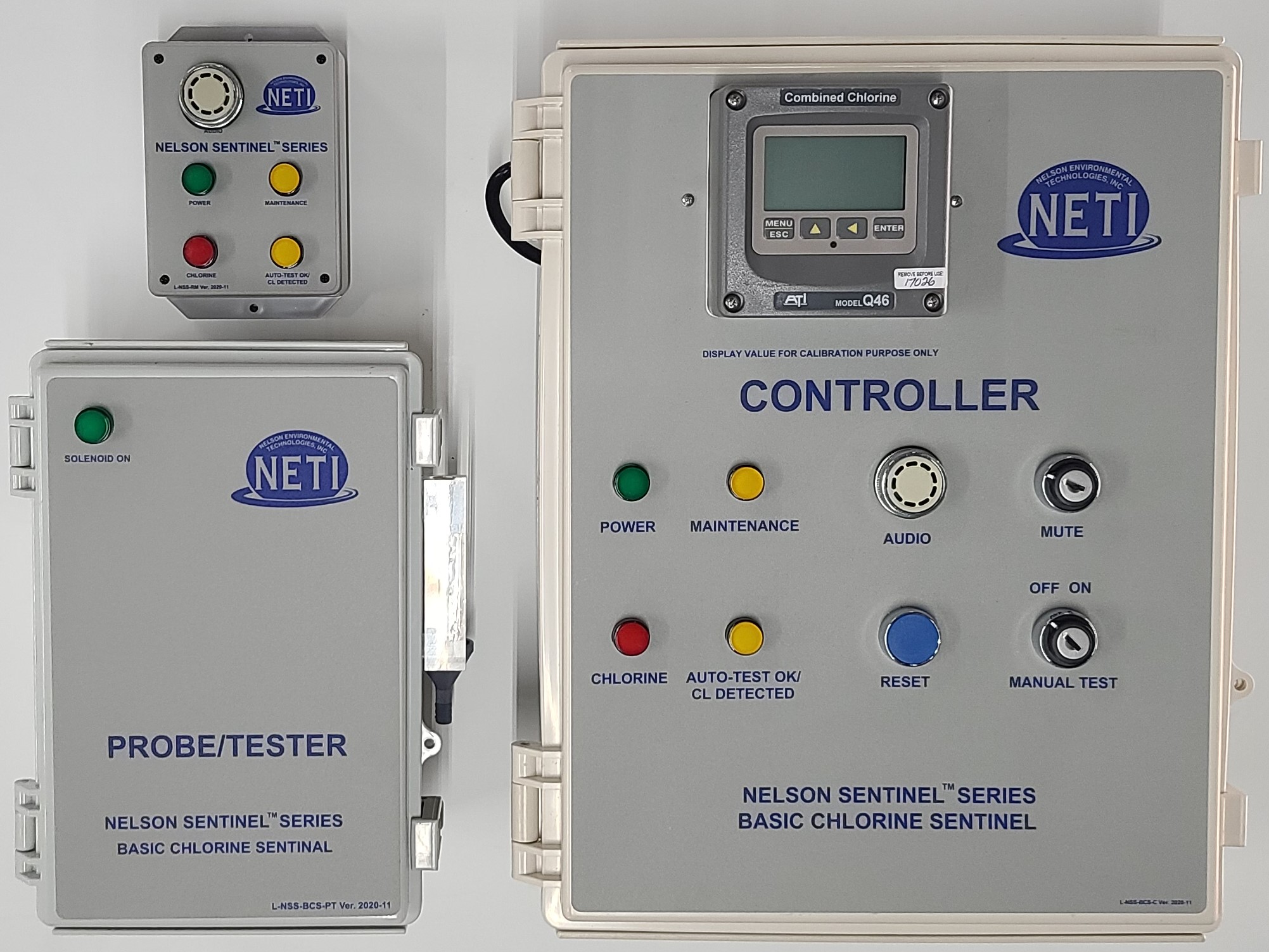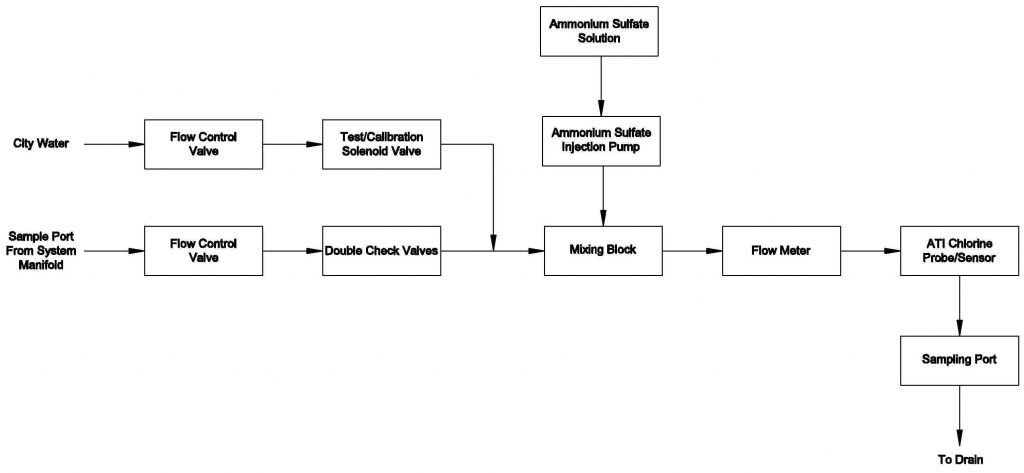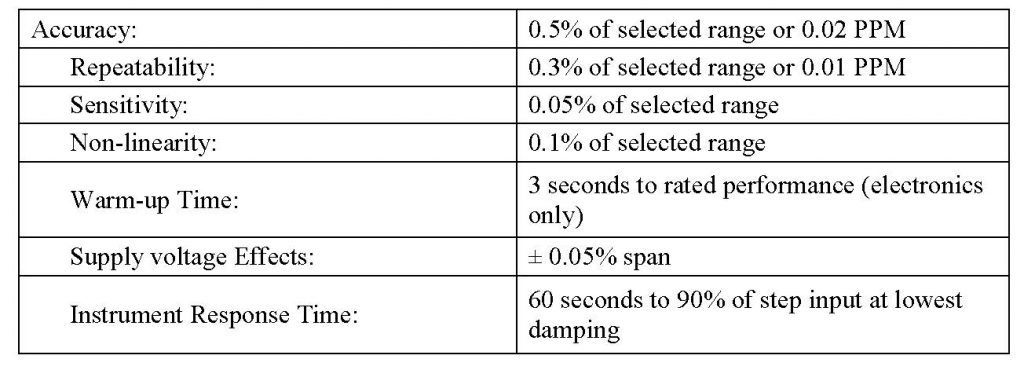BASIC CHLORINE SENTINEL™

Indications for Use
The Nelson Sentinel Series Basic Chlorine Sentinel™ is an instrument that is intended for use by hemodialysis professionals as an auxiliary device to provide continuous monitoring of Total Chlorine (i.e. total chloramines pus ammoniated free chlorine). It is not intended to replace the primary method for monitoring total chlorine as part of the hemodialysis water treatment system. It functions completely independent of the water treatment system and does not come into direct contact with feed water used to prepare dialysate.
Overview
The device is designed to work in the background and the user needs only to document the status of the red and yellow lights then reset the yellow Auto-Test/Chlorine Detected light at the beginning of the day. The device requires periodic maintenance at which time the biotech needs to replace the ammonium sulfate bad in the Probe/Tester enclosure, replace the probe membrane and electrolyte, and recalibrate the Probe.
The Basic Chlorine Sentinel™ devices uses a combined chlorine sensing probe. Therefore, to ensure that the device is detecting total chlorine within the monitored range, ammonium sulfate (which converts free chlorine into combined chlorine) is inject into the sample water stream before the combined chlorine sensor.
Figure 1: Flow diagram of sample water through the Basic Chlorine Sentinel™

The chlorine detecting probe may be placed at any location that the customer wishes to monitor. However, the recommended location to monitor chlorine is directly after the second carbon filter, as this is the water that goes to the reverse osmosis (RO) machine. The primary chlorine detection system of the water treatment system samples water after the first carbon filter a few times a day. If chlorine should enter and pass through the primary carbon filter between tests, the secondary carbon filter is designed to provide the required protection for the patient. However, if the secondary carbon filter fails (and this is not easily identifiable), the chlorine will go to the RO. The Basic Chlorine Sentinel™ will alert management immediately if that should occur.
The unit is used to monitor chlorine at a pre-set trigger point, which is factory set at 0.10 mg/L. When the total chlorine is equal to or above 0.10 mg/L, the red Chlorine alarm indicators and the yellow Auto-Test OK/CL Detected indicators will activate. The Buzzers will activate at the same time and cannot be deactivated. The indicators and buzzers will be active as long as the chlorine event is sensed. After the chlorine event passes, the red Chlorine alarm indicators and the Buzzers are deactivated. The yellow Auto-test OK/CL Detected indicators remains on until the Reset pushbutton is pressed or the next auto-test is performed.
The device has a screen mounted on the front cover of the Controller enclosure, which is used for calibrating the device against a reference device (such as Hach PC or a similar instrument, which can be calibrated to international standard).
The yellow Maintenance needed indicator and buzzers are energized by either a channel fail signal from the Chlorine Analyzer or by one of the Auxiliary Inputs activated. The buzzers cannot be deactivated without the key. The indicator will remain energized until the event which is causing it to energize has ended.
System Features
- System monitors both dissolved free chlorine and dissolved chloramines (and other dissolved oxidants in high concentration) for total chlorine protection.
- Design optimized for easy installation and user friendliness.
- ABS, IP65 water-resistant, V1 fire rated, lockable Controller enclosure.
- Easy installation to sample port drains of existing water treatment system.
- High accuracy — +/- 0.02ppm, repeatability — +/- 0.01ppm.
- Daily automatic self-testing to ensure proper equipment functionality.
- Chlorine analyzer/alarm channel failure alarm.
- System power failure alarm.
- Remote module with alarm enunciator, red chlorine alarm indicator, yellow latched chlorine detected indicator, yellow maintenance needed indicator, and green power on indicator.
- High accuracy, high sensitivity system, measures from 0.02 mg/L to 0.200 mg/L.
- Output Fail Alarm feature allows system diagnostic failures to be sent to external monitoring systems.
- Large, high contrast, custom LCD display with LED back indicator provides excellent readability in any indicator conditions. The secondary line of display utilizes 5×7 dot matric characters for clear message display. Two of four measured parameters may be on the display simultaneously.
- Diagnostic messages provide a clear description of any problem with no confusing error codes to look up. Messages are also included for diagnosing calibration problems.
- Quick and easy one-point calibration method and sensor zero-cal. To provide high accuracy, all calibration methods include stability monitors that check temperature and main parameter stability before accepting data.
- High accuracy three-wire Pt1000 temperature input. Temperature element can be user calibrated.
- Security lock feature to prevent unauthorized tampering with analyzer settings. All settings can be viewed while locked, but they cannot be changed.
- Provides outputs for connection to a clinical facility’s alert system (e.g. Auto-Dialer, SMS, or Pager alert systems).
Device Accuracy
The Basic Chlorine Sentinel™ uses one of the most accurate chlorine analyzers in the market today*. However, in the application, the device’s accuracy when used in conjunction with a Hach PC for both calibration and reference purposes has a 95% confidence level of +/- 25%. This is due mainly to the small levels of chlorine concentration and with issues associated with the Hach PC. Its published accuracy is 0.02 mg/L and it measures chlorinated suspended solids in its total chlorine reading. The current IS 13959:2014 standard limit for dissolved chlorine is 0.1 mg/l of chloramines (combined chlorine); 0.5 mg/L of free chlorine. The implied tolerance is +/- 50% of the least significant digit for both combined and free chlorine. Thus, the Sentinel’s apparent consistency of +/- 25% is well within the Standard’s chlorine tolerance.
In field testing, if the influent water has 100% free chlorine (no combined chlorine) and no BOD demand in its distribution, a concentration level approximately 0.58 mg/L may not trigger the Basic Chlorine Sentinel™ set-point for notification if the Ammonia Sulfate injection system should fail. This is approximately 0.08 mg/L over the upper free chlorine tolerance limit of 0.55 mg/L. The Standard’s 0.5 mg/L for free chlorine is noted as being a judicious limit, not based upon proven patient risk.
*Chlorine Analyzer’s publish performance data

Physician Prescription Required
This medical device has FDA K193169 clearance and requires a physician’s prescription.
System Description
The Basic Chlorine Sentinel™ is a complete system that attaches to the drain of a hemodialysis water treatment system sample port. It detects total dissolved chlorine by an auxiliary amperometry detection technology, self-monitors for maintenance required conditions, loss of electrical power, as well as two other system conditions such as flooding and RO shutdown alarm. The device is preferably placed after the second carbon filter, before the RO machine or at the beginning of the patient water treatment loop.
The device has three components – a lockable master control enclosure, a lockable probe/tester enclosure, and the remote module installed in the patient area.
A chlorine concentration equal to or above the set-point will activate:
- the Buzzers;
- the red Chlorine alarm indicators;
- the yellow Auto-Test OK/CL Detected indicators;
for as long as the condition exists. The Buzzers cannot be muted and both red and yellow indicators will remain on.
After the chlorine event is over:
- the Buzzers deactivate;
- the red Chlorine alarm indicators deactivate;
- the yellow Auto-Test OK/CL Detected indicators remain activated.
The Auto-Test OK/CL Detected are deactivated by pressing the blue Reset pushbutton on the front cover of the Controller.
A probe failure or the activation of one of the auxiliary input relays will activate the yellow Maintenance needed indicators as well as the Buzzers which will remain activated as long as the condition exists. However, the Buzzers can be muted the Keyed Mute Switch while the maintenance issue is being resolved.
The device will self-diagnose its function ability daily – default set at 02:00AM. During the test, chlorinated city water is injected into the device. If the device is functioning properly, the chlorine that is being monitored will cause the red Chlorine alarm indicators and buzzers to activate once the concentration equals or exceeds the trigger point – default set at 0.10 mg/L. That will latch the yellow Auto-Test OK/CL Detected indicator. Once the chlorine is detected over the set-point, the chlorinated water injection is terminated. The latched yellow Auto-test OK/CL Detected indicator will remain on advising the user that the device is functioning correctly. If the yellow Auto-Test OK/CL Detected indicators are not on when checking to see if the test was successful, then the user needs to follow protocol advising management of the auto-test failure.
The device is designed to work in the background. It requires no user inputs unless a chlorine event or other monitored event is detected. However, the user should note the condition of the indicators in a log each day and reset the yellow Auto-Test OK/CL Detected indicator by pushing the blue Reset pushbutton. If the Auto-Test OK/CL Detected indicator is not reset manually, it will be reset automatically at the beginning of the next auto test.
Users can also manually test the performance of the device by using a supplied key to turn the Manual Test Switch to “ON” position. Once monitored chlorine concentration reaches the trigger point, the red Chlorine alarm indicators will activate for as long as chlorine is above the trigger point. The yellow Auto-Test OK/CL Detected indicators will remain on until Manual Test Switch is turn OFF and reset by pressing the blue Reset pushbutton. During the manual test procedure, the Buzzers will not be activated. This is to ensure that any patients present at the time of the manual test will not be disturbed by the audio device.
Four outputs are available for use with remote notification devices for any four out of the five following signals:
- Chlorine is detected above a set-point in water;
- Chlorine probe channel failed;
- Electrical power failure;
- Aux. 1 input (flood sensor/other input) is detected;
- Aux. 2 input (RO alarm/other input) is detected.
